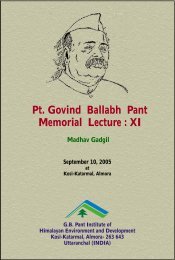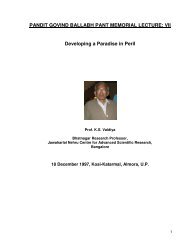Pandit Govind Ballabh Pant Memorial Lecture: II
Pandit Govind Ballabh Pant Memorial Lecture: II
Pandit Govind Ballabh Pant Memorial Lecture: II
You also want an ePaper? Increase the reach of your titles
YUMPU automatically turns print PDFs into web optimized ePapers that Google loves.
Added to it is a whole range of medicinal and aromatic plants some of which have<br />
gone into commerce and have their centre of origin in the Himalaya. Among the<br />
important ones are Asparagus racemosus, Atropa acuminata, Aconitum<br />
heterophyllum Berberis spp. Bunium persicum, Carum sp., Colchium luteum, Coptis<br />
teeta, Cymbopogaon spp., Cucuma zedoaria, Digitalis purpurea, Dioscorea<br />
deltoidea, Ephedra gerardinana, Gentiana kurroa, Heracleum spp., Hyocyamus<br />
niger, Inula spp., jurinea macrocephala, Mentha arvensis, Nardostachys jatamansi,<br />
Orchis latifolia, Papaver somniferum, Physochlaina praealta, Podophyllum<br />
hexandrum, Picrrohiza kurroa, Rheum emodi, Sausurea lappa, Swertia spp.<br />
Valeriata wallichii, Viola odorata, etc. Most of the medicinal plants used in<br />
indigenous system are at present extracted from nature.<br />
In addition, wild progenitors of a number of ornamentals are found in the<br />
Himalaya. Special mention must be made of species of Primula, Rhododendron and<br />
whole range of orchids. Bamboo wealth of Himalaya particulary eastern region is<br />
consderable. Many species of bamboos extend uupto Western Himalaya, except<br />
Kashmir Valley.<br />
The Himalayan region harbours many wild and domesticated animal species<br />
whose abode falls on this region.<br />
Conservation of Biota<br />
12<br />
Faculty policies on land, agriculture, foresty, grazing, animal husbandry, fishing,<br />
wildlife and tourism have resulted in habitat loss leading in turn to loss of biodiversty.<br />
Equally important has been the lack of trained manpower, public awareness and<br />
lack of financial support. Furthermore, conservation particulary in situ is no in the<br />
mainstream of biosciences. Thus conservation of biodiversity has lagged behind as<br />
far as its scientific and technological content is concerned (Khoshoo 1991).<br />
Biodiversity is the sum total of species richness (i.e. number of species of plants,<br />
animals and micro-organisms) living in a community or an ecosystem. The tropical<br />
regions are vastly richer in biodiversity than the Polar Regions. Genetic diversity is<br />
part of biodiversity and pertains to the heritable diversity at the species level. It is the<br />
basic building block for organic evolution, hence it also affects the evolution and<br />
success of a community or an ecosystem. Genetic diversity is also a critical input to<br />
agriculture, horticulture, forestry, animal husbandry, fisheries and bio-industry,<br />
Biodiversity in general, genetic diversity in particular is today highly politicized issue,<br />
much to the disappointment of the scientist who care for the underlying science and<br />
service to the society. Politicalization has been the result of the interest taken by<br />
multinational corporations, businessmen, diplomats, bureaucrats, politicians and the<br />
press (Khoshoo 1987).<br />
Fig. 8: Interactive components of biosphere. Source: Khoshoo, 1997<br />
In nature biodiversity is supported by two major factors; the ecological process,<br />
and organic evolution (Fig. 8). There are reciprocal effects between the three. For<br />
ensuring that biodiversity is in good health, the processes supporting it need to be<br />
27











